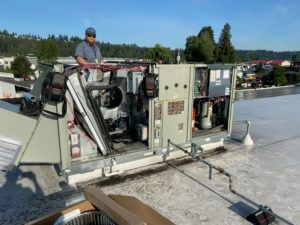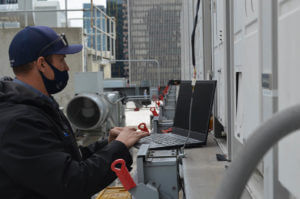A commercial HVAC system controls the temperature, air quality, and humidity in large spaces like office buildings, schools, hospitals, and shopping centers. Unlike smaller systems used in homes, commercial HVAC systems are bigger and stronger because they need to handle larger spaces and more people.
The goal of a commercial HVAC system is simple: keep the building comfortable and the air clean, no matter what’s happening outside.

Here are the main parts that keep a commercial HVAC system running smoothly:
- Heating System
- The heating system keeps your building warm during colder months. This can include:
- Furnaces: Machines that heat the air using natural gas, oil, or electricity.
- Boilers: These heat water or steam and send it through pipes to warm the building.
- Heat Pumps: A modern option that pulls heat from the air or ground outside to warm the building.
- The heating system keeps your building warm during colder months. This can include:
- Cooling System
- To keep things cool in the summer, commercial HVAC systems use air conditioning units or chillers. These systems pull heat out of the air to lower the temperature.
- Chillers: Common in large buildings, chillers cool water and send it through the system to cool the air.
- Split Systems: These separate the cooling parts into indoor and outdoor units.
- To keep things cool in the summer, commercial HVAC systems use air conditioning units or chillers. These systems pull heat out of the air to lower the temperature.
- Ventilation System
- The ventilation system is responsible for bringing in fresh air and pushing out stale air. It also helps filter out dust, allergens, and other particles so everyone can breathe easier.
- Ventilation systems include:
- Air Ducts: Carry air throughout the building.
- Fans: Move air in and out.
- Filters: Remove dirt and debris from the air.
- Thermostats and Controls
- These devices help you control the temperature, airflow, and humidity inside the building. Modern systems can even adjust automatically to keep things comfortable while saving energy.
- Air Ducts and Vents
- Air ducts and vents are the pathways that move heated or cooled air around the building. If the ducts are well-designed and properly sealed, the system works more efficiently.

- Air ducts and vents are the pathways that move heated or cooled air around the building. If the ducts are well-designed and properly sealed, the system works more efficiently.
How Does a Commercial HVAC System Work?
Here’s a simple breakdown of how commercial HVAC systems do their job:
- It Starts with the Thermostat
- The thermostat senses if it’s too hot, too cold, or needs more fresh air. Once it detects what’s needed, it sends a signal to the HVAC system.
- Bringing in Air
- The system pulls in air from outside or reuses indoor air, depending on what’s needed. Filters clean the air to remove dust and other particles.
- Heating or Cooling the Air
- The air is heated (using a furnace, boiler, or heat pump) or cooled (using air conditioners or chillers) to reach the right temperature.
- Moving the Air
- Once the air is ready, it’s pushed through ducts and vents to spread it evenly throughout the building.
- Removing Stale Air
- At the same time, stale air is pushed out of the building, and fresh air is brought in to keep things clean and comfortable.
- Controlling Humidity
- The system can also adjust humidity levels to make sure the air isn’t too dry or too damp.

Common Types of Commercial HVAC Systems
Different buildings have different needs, so there are a few types of HVAC systems to choose from:
- Single-Split Systems
- Great for smaller buildings, these systems include one indoor unit and one outdoor unit. They’re affordable and easy to install.
- Multi-Split Systems
- Similar to single-split systems, but multiple indoor units connect to one outdoor unit. This works well for buildings with several rooms.
- Variable Refrigerant Flow (VRF) Systems
- These systems are energy-efficient and can heat or cool different parts of the building at the same time. Perfect for mid-sized to large buildings.
- Rooftop Units (RTUs)
- As the name suggests, these systems sit on the roof and handle heating, cooling, and ventilation all in one package. They’re common in larger buildings.
- Chillers
- Chillers cool water, which is then circulated through the building to cool the air. These are ideal for very large spaces.
Commercial HVAC systems work hard, so they need regular maintenance to stay efficient and reliable. Here’s what regular check-ups can include:
- Cleaning air filters, ducts, and coils.
- Checking refrigerant levels for cooling systems.
- Testing thermostats and controls to make sure everything is working properly.
- Inspecting parts to catch small problems before they become expensive repairs.
Taking care of your HVAC system helps it last longer, reduces energy costs, and prevents unexpected breakdowns.
Commercial HVAC systems are the heart of any building, making sure it stays warm, cool, and filled with clean air. Whether you run an office, school, hospital, or shopping center, a reliable HVAC system keeps everyone comfortable and happy.
If you want to keep your HVAC system in top shape or need help choosing the right system for your building, reach out to us. We’re here to help you stay comfortable, efficient, and worry-free!